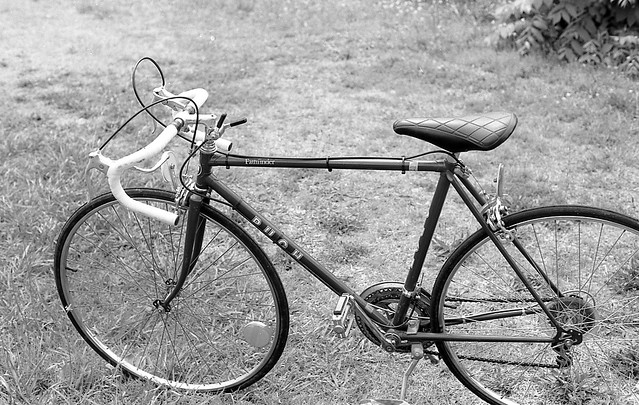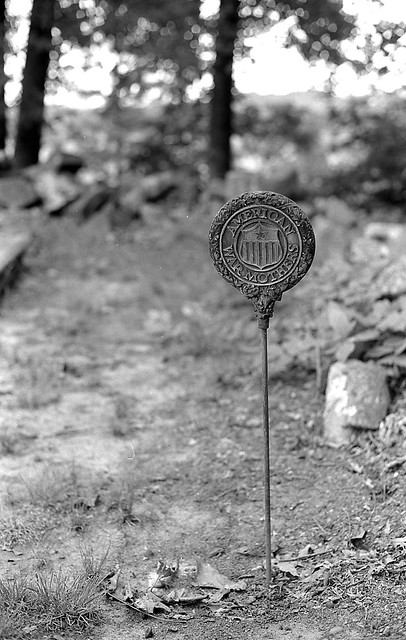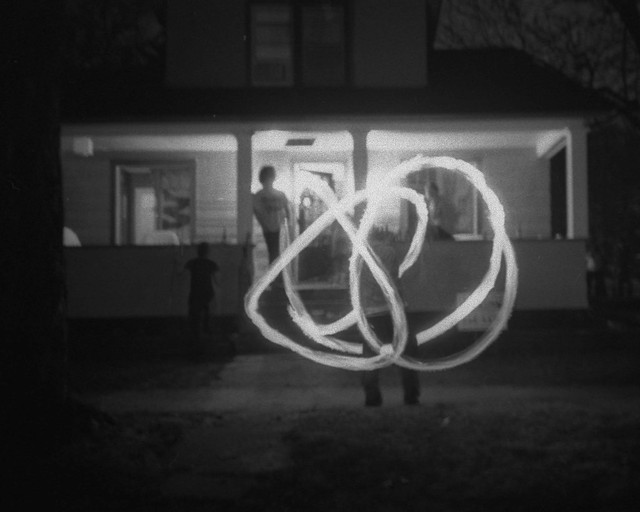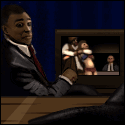|
Paul MaudDib posted:So someone mentioned doing pushing with Rodinal 1:100 for 1.5h. I have a batch of mixed exposure film (some 400, some 1600) that I didn't label and now it's mixed up. Rodinal 1:100 for 1h is usually a pretty good mystery-film recipe, I'm wondering if the 400 would still be usable at that level of development. It would probably work! Remember to let it sit perfectly still after the first 30 seconds, except for agitating (one inversion) at an hour. This is what I did.
|
|
|
|

|
| # ? May 9, 2024 00:40 |
|
Any opinions on Fujifilm Reala 100 in 120? I was going to buy a pro pack since it's relatively cheap but I was just curious about the films tendencies (e: as opposed to Ektar 100 I guess).
mes fucked around with this message at 05:40 on May 27, 2012 |
|
|
|
Mest0r posted:Any opinions on Fujifilm Reala 100 in 120? I was going to buy a pro pack since it's relatively cheap but I was just curious about the films tendencies (e: as opposed to Ektar 100 I guess). I really like Reala. It has what I would consider to be a realistic palatte - normal C-41 colors, generally more saturated, particularly if you overexpose more than a stop, but not unrealistically so. I'd honestly compare it to Fuji Provia 120 without the tendencies toward color casts. It's quite different from the Porta palatte, but I like it. It certainly is much much more forgiving of exposure errors than Ektar (which is as unforgiving as a slide film). These were all shot with Reala, and should give you a decent idea what it looks like. Note that the first 4 are minilab scans and they really suck, the color is probably off a lot.
|
|
|
atomicthumbs posted:It would probably work! Remember to let it sit perfectly still after the first 30 seconds, except for agitating (one inversion) at an hour. This is what I did. I think stand and semi-stand works more or less like this: True stand (agitation for 30s, leave still for 1h) gets you rated speed. Semi-stand with one additional agitation (initial 30s, leave for 1h with 30s after the first 30m) gets you 1 stop push. Two additional agitations over that (30s initial, three further 30s over the 1h) gets you a two stop push. It's not exactly scientific, but as a rule of thumb that has worked pretty well for me.
|
|
|
|
|
I tend to do more "true" stand development with Rodinal, if you're after the rated value, go 1hr with 1min inversions at the start, if you're looking to push (pretty much anything up to something like 400->3200) I go for a full 2hrs with another 1min of inversions at the 1hr point.
|
|
|
|
2 hours seems like it might block things up a bit with the stuff I exposed at rated ISO instead of a 2-stop push. Too much is generally better than too little, but I could also try selenium intensification on the weak roll. Choices, choices.
|
|
|
|
So here I have two different ISO films (400 on the left, 200 on the right) from the same camera, a Vivitar PN2011. Now, my issue is that the ISO 200 film looks off (and I can't find the word to describe it. Too washed out?) and I was wondering if this is just regular occurence and I should just use ISO 400 film from now on. But when I finished my 400 rolls, I modified the camera to do multiple exposures, and I messed with the lens itself. Just unscrewed the housing it was in, looked at it, and put it back in place. So I'm wondering if that had anything to do with why the photos developed so strangely. I must stress I'm new to shooting film, and these are literally my first rolls, so I don't have any insight of my own as to what the issue is with this.
|
|
|
|
Is the 200 expired?
|
|
|
|
Deputy Dangerous posted:Now, my issue is that the ISO 200 film looks off (and I can't find the word to describe it. Too washed out?) and I was wondering if this is just regular occurence and I should just use ISO 400 film from now on. But when I finished my 400 rolls, I modified the camera to do multiple exposures, and I messed with the lens itself. Just unscrewed the housing it was in, looked at it, and put it back in place. So I'm wondering if that had anything to do with why the photos developed so strangely. I must stress I'm new to shooting film, and these are literally my first rolls, so I don't have any insight of my own as to what the issue is with this. I'm gonna need more info here. Were these minilab scans? If so, the scans could just be hosed up. Take out your negatives, hold them up to the light, and compare the relative density (how dark the exposed areas are). Is the 200 really thin/transparent? That can gently caress up minilab scans, but you can do a better job yourself. Minilab prints are made from minilab scans, by the way. Make sure that you're getting a good scan/snap of the negative. You want the white/black points to be at the edge of the histogram. That looks kind of like you have your white/black points set really far out, so you're losing all your contrast. If they go too far inside the histogram, the scan will clip and you'll lose shadows/highlights. I don't think it's a camera problem, probably. The most likely thing you'd have done would be a light leak, which would probably manifest itself as all of your images having a spot in a specific area or being solid black. It could be flare, but it wouldn't happen in every single image.
|
|
|
|
The photos are indeed minilab scans. Looking at the relative density, the 200 negatives look a lot darker and less definable than the 400 negatives. I'll report back when I finish the current 400 roll inside it and get it developed; if that looks fine then I'll just stick with 400.
|
|
|
|
Deputy Dangerous posted:So here I have two different ISO films (400 on the left, 200 on the right) from the same camera, a Vivitar PN2011. That's a fixed-exposure camera (f/8 1/125) so 200 speed film in bright sun might just be overexposed.
|
|
|
|
Paul MaudDib posted:I really like Reala. It has what I would consider to be a realistic palatte - normal C-41 colors, generally more saturated, particularly if you overexpose more than a stop, but not unrealistically so. I'd honestly compare it to Fuji Provia 120 without the tendencies toward color casts. It's quite different from the Porta palatte, but I like it. It certainly is much much more forgiving of exposure errors than Ektar (which is as unforgiving as a slide film). I'll probably just pick up a few rolls of it just to see how I like it, I just want something with a little more bite than the Portra I've been using.
|
|
|
|
Beastruction posted:That's a fixed-exposure camera (f/8 1/125) so 200 speed film in bright sun might just be overexposed.
|
|
|
|
HPL posted:Wouldn't it be the other way around? It would be about 3 stops overexposed if you're going with the sunny-16 rule (f/16, 250th, no?).
|
|
|
|
Mest0r posted:It would be about 3 stops overexposed if you're going with the sunny-16 rule (f/16, 250th, no?).
|
|
|
|
HPL posted:No, I mean compared to 400 film. The long shadows and orange light make me think it was shot late in the day.
|
|
|
|
Important public safety announcement: if you are using a motor roller base with anything that uses a screw-top lid, I recommend you take the following precautions: 1. Tighten the lid down hard 2. Your roller will push the drum/tank in one direction. Look at the axis of rotation, it should turn in a direction such that if it contacts something it will tighten the lid, rather than loosen. 3. Ideally, get a big plastic tub and set the roller base in there, this will contain any spills that might occur. I just put a liter of fixer all over my kitchen floor. I think I've got it cleaned up, I dried everything off and washed it twice with a wet dish towel. I really, really hope it's all up.  e: It was just a Really Bad Day all around. Other highlights included dropping and almost kinking a reel of 120, discovering one roll had actually been torn off in the camera (I must have loaded it straight from the body), and being unable to find at least one other roll (that I thought I was developing tonight), and my bottle of HC110 leaking allover loving everything.  At least the fixer was fresh-mixed so the toxicity isn't as bad as it could have been. At least the fixer was fresh-mixed so the toxicity isn't as bad as it could have been.
Paul MaudDib fucked around with this message at 08:47 on May 29, 2012 |
|
|
|
yay, i've ordered chemicals. i've no idea exactly WHICH chemicals i've ordered, guy at the photo store talked fast and smooth :V
|
|
|
|
Here's a PSA to say that if you send your film to Dwayne's ever, don't bother with the scans. I just got my first batch back from them. A couple of my negatives have weird color lines, but other than that they looks okay. My 6x7 scans are all 3 megs each though, and all kinda blurry, even though the negs look crisp. That's... tiny. Thought I could save myself some time by paying a little extra to get scans done, but I guess you get what you pay for in that department.
|
|
|
|
QPZIL posted:Here's a PSA to say that if you send your film to Dwayne's ever, don't bother with the scans. I just got my first batch back from them. Is there anyone that does worthwhile scans for a reasonable price?
|
|
|
|
HPL posted:No, I mean compared to 400 film. In other news, looks like NYC has enough film interest to warrant the opening of new E6 labs. Hooray!
|
|
|
|
notlodar posted:In other news, looks like NYC has enough film interest to warrant the opening of new E6 labs. Hooray! I doubt I'll be able to get E-6 even sent away by my local camera shop by the end of this year. That *somebody* is still processing it is a good sign.
|
|
|
|
eggsovereasy posted:Is there anyone that does worthwhile scans for a reasonable price? I don't think North Coast Photo is that unreasonable for budget scans. The file sizes are 3-5mb. When uncompressed and open in Photoshop they are around 25-30mb. However, it's only really a deal if you get your film developed first because the machine they use to develop the film then feeds it directly into the scanner, so they give you a discount on the scanning if you get your film developed through them. If you just send in a roll of film to be scanned it's more expensive, and I think they use separate equipment for that. So really, no good deals to be had that I know of for film to be developed at a quality level. It's either cheap and poor quality, expensive for good quality, and extremely expensive for the best quality (drum scans at like $100+ per image). NCPS falls in the middle - reasonable deal for good quality (if you do the budget scan after paying for development).
|
|
|
|
Oh my heavens Acros is gorgeous Pukey by iantuten, on Flickr  Cemetary by iantuten, on Flickr
|
|
|
|
Mannequin posted:I don't think North Coast Photo is that unreasonable for budget scans. The file sizes are 3-5mb. When uncompressed and open in Photoshop they are around 25-30mb. However, it's only really a deal if you get your film developed first because the machine they use to develop the film then feeds it directly into the scanner, so they give you a discount on the scanning if you get your film developed through them. I have a couple rolls of E100G I need to shoot, so I'll mail it out to them whenever I get around to it and I'll try their scans. Do you touch up your photos from their scans, or do they pretty much come how you like?
|
|
|
|
eggsovereasy posted:I have a couple rolls of E100G I need to shoot, so I'll mail it out to them whenever I get around to it and I'll try their scans. They come out how I like. I really don't do much tweaking at all unless I've made an exposure error and then I have to potentially do a bit of work. But with film there's not always a lot you can do to fix it without spending a lot of time, and I don't like to spend a lot of my time fixing things. If you expose correctly at the time of the shot then everything will fall into place.
|
|
|
|
I finally have time to develop, cut, and scan some of my negatives again!    I threw a few more firetwirler images into a set, but I don't think they're as interesting as those two. KEH finally gave up on my GS645, they're 2-day shipping me an EX (I think) GS645 with case to make up for the fact that they've had mine for like six months now.
|
|
|
|
Mannequin posted:They come out how I like. I really don't do much tweaking at all unless I've made an exposure error and then I have to potentially do a bit of work. But with film there's not always a lot you can do to fix it without spending a lot of time, and I don't like to spend a lot of my time fixing things. If you expose correctly at the time of the shot then everything will fall into place. How big are the scans, just say for a 6x6 negative?
|
|
|
|
A new addition in form of a 1.8 50mm for the ol' AV-1 and some Ilford B&W 400 film (never shot black and white before) made shooting film all the more fun all of a sudden. Why didn't I pick up this lens sooner? The best forty bucks ever spent.    
|
|
|
|
I just made my first prints in my new home darkroom! The entire setup (enlarger, accessories, chemistry) cost me $70. My timer is a piece of poo poo and the lens board is duct taped to the lamphead, but I MADE A DARKROOM GOD DAMMIT. p.s. Cleaning up chemistry is the worst thing ever.
|
|
|
|
Anyone have experience with the Canonet QL17 GIII? Mine is having inconsistent spacing with the frames, it hasn't been that big of a problem until the I shot last roll had two of the frames overlapped slightly. Searching around isn't giving me much of a solution of the problem.
|
|
|
|
Mest0r posted:Anyone have experience with the Canonet QL17 GIII? Mine is having inconsistent spacing with the frames, it hasn't been that big of a problem until the I shot last roll had two of the frames overlapped slightly. Searching around isn't giving me much of a solution of the problem. I have two QL17s. One had the frame overlapping problem and one has a thing where it doesn't really stop winding between frames. I took the latter one apart and I can see where a lot of the problems come from because the thing that stops the film winding mechanism is a super flimsy piece of thin stamped sheet metal.
|
|
|
|
I picked up an old Minolta film camera and bought a roll of 400TX. I read (on page 1) that if I take it to a photo lab for processing then my photos will look lovely. So two questions, really. What is so lovely about the way a lab processes the B&W film? Also, is it more risky for me to try to develop my first roll of film ever myself?
|
|
|
LargeHadron posted:I picked up an old Minolta film camera and bought a roll of 400TX. I read (on page 1) that if I take it to a photo lab for processing then my photos will look lovely. So two questions, really. What is so lovely about the way a lab processes the B&W film? Also, is it more risky for me to try to develop my first roll of film ever myself? It's more a question of whether the lab usually processes traditional B/W film at all. They might not have the chemistry readily mixed or a machine to handle it, so you can risk having to pay someone's hourly wage to have it developed. Or maybe they have stale chemistry, which will at least give poor results. Or maybe they gently caress up royally and put it through C-41 chemistry which will simply ruin the film. Alternatively you can use Ilford XP2 or Kodak BW400CN film, which are also B/W but for C-41 process, so any lab can handle it.
|
|
|
|
|
LargeHadron posted:I picked up an old Minolta film camera and bought a roll of 400TX. I read (on page 1) that if I take it to a photo lab for processing then my photos will look lovely. So two questions, really. What is so lovely about the way a lab processes the B&W film? Also, is it more risky for me to try to develop my first roll of film ever myself? I think you may be misunderstanding what was said on page one (this is from memory) - the problem is actually that a lot of labs can't do B&W film because it's a manual process that they can't do with their automatic machines (the way they can with color films). If you can find a professional enough photo lab, they may be able to do B&W film. If that's the case, your negatives will probably look fine. If you'd rather do it yourself, and you can follow the directions (develop->stop->fix->clear->wash), it's only minimally risky. Even then the only hurdle is getting the process down.
|
|
|
|
LargeHadron posted:I picked up an old Minolta film camera and bought a roll of 400TX. I read (on page 1) that if I take it to a photo lab for processing then my photos will look lovely. So two questions, really. What is so lovely about the way a lab processes the B&W film? Also, is it more risky for me to try to develop my first roll of film ever myself? The only lab that can process true B&W film is a real lab, and they won't (can't) just chuck it in a machine with a dozen other rolls. It has to custom-developed, almost always by hand, and you will be charged accordingly. Minilabsódrugstores, Costco, Sams, Ritz/Wolf/Kitsócan only process C-41 color film. If their attendants are paying attention, your film will be returned unopened and unharmed. If they're not, you'll get back several feet of blank acetate. B&W film retains a permanent image composed of silver. Dye, not silver, is the permanent part of a color negative, so all the silver is removed during processing. If you can follow instructions, developing it yourself is easy and far, far cheaper (assuming you're going to do more than one roll within the next six months or so). Molten Llama fucked around with this message at 15:16 on Jun 8, 2012 |
|
|
|
LargeHadron posted:I picked up an old Minolta film camera and bought a roll of 400TX. Develop the film yourself. Do what I did, based on suggestions here, and find somebody on Craigslist / Kijiji / Gumtree / garage sale unloading their developing stuff. There's a list in this thread somewhere - somebody post the page number so I don't have to - of things you'll need, which you can buy new for under $100 (probably well under) or second-hand; I got everything I need for $50 from somebody getting out of it. It is not at all difficult. Not even a little. Can you tie your shoes without looking at them? Can you mix a drink that doesn't taste like poo poo? That's the minimum level of competence needed to develop B&W film.
|
|
|
|
ExecuDork posted:First, well done. Which old Minolta did you get? I love my X-700, even though I don't take it out as often as I should. And 400TX is good stuff. It's a 7000. I bought it for the lens to put on my Sony but I turned it on and got obsessed with trying out film.
|
|
|
|
Mannequin posted:They come out how I like. I really don't do much tweaking at all unless I've made an exposure error and then I have to potentially do a bit of work. But with film there's not always a lot you can do to fix it without spending a lot of time, and I don't like to spend a lot of my time fixing things. If you expose correctly at the time of the shot then everything will fall into place. Are you kidding? Saving missed exposures is a feature of film, much moreso than digital. Nearly every negative film will handle a LOT of overexposure, 2 stops easily. The more you overexpose, the more the highlights block however, and eventually you will get some color shift in color film. On the flip side, you can painlessly save an exposure down to about 1/2 or 1 under. At least double if not 4x those for Portra 400. Minilab scans suck, but with good scanner technique you can easily get an image that most casual viewers would consider acceptable. I'd imagine even really bad exposures can be saved by playing with the histogram, contrast, exposure, and lamp power to capture highlights+shadows and then masking in photoshop, but I've really never had a problem. I've got some Tri-X my girlfriend shot at ISO 12-25-ish (I think), visually they're just little blackened squares but you can still scan a usable image out of them. If you wet print B+W, you may be able to recover an even better image using split filter printing (you can separate and control both the highlights and the shadows directly). The problem is you like slide films. They have a unique palette, but they have a very narrow exposure range and when detail is gone it's gone, much like when digital images clip. Now, it's still not *that* narrow - I shot a roll of Provia on my TLR where I'd meter once every 10 mins or so with my P67 and just roll with the averaged exposure until the light changed severely, using my best-guess adjustments, and it worked fine. You have to be able to deduce how your meter is analyzing the image and place the relative luminosity on the Zone scale. For example, 'tis the season for graduation parties, and one afternoon you're shooting a picture of some friends under a thick tent with a brightly backlight lawn behind. You'll want to take the averaging exposure and increase it about 1.5-2 stops, since that's roughly the difference between a very closed shadow and normal sunlight minus a bit for the shaded area of the image. You can get pretty accurate readings here with poor equipment if you know what it's doing and what you want. Nowadays I don't even use a meter for negative films anymore, I just set a sunny f/11 equivalent exposure and roll with it. Full closed shadows are f/4, most are f/5.6, lightly shaded (i.e. wispy cloud) is f/8, normal sunshine is f/11, full midday sun on the beach is f/16, inside is as slow as you want to risk handholding given the light (1/30-1/60 f/1.4 at ISO 400 is a good rule of thumb for an average household illumination at night). For example, that graudation shot is probably f/4 or f/5.6, shutter 1/ISO. You can use those guesses to alter your meter readings too - moving from an open outdoor area to a forested area? Add 2 stops, it should be right in the ballpark. Find yourself some rules of thumb that work for you. Shoot negative film if you're seriously concerned about blown highlights/shadows, meterless, or in a potentially changing situation. Practice some ways to recover your blown exposures. Toy with the image colors in Photoshop, maybe take the same image twice with negative and a well-exposed slide and see if you can get it to match the colors properly and note the changes it makes to the curves/sliders if you can. Learn to push rolls to save the shots you want (more development is better than less, to a point), or bracket around on important shots. And remember, an interesting shot will cover a world of sin in missed technique anyway. Paul MaudDib fucked around with this message at 10:41 on Jun 10, 2012 |
|
|
|

|
| # ? May 9, 2024 00:40 |
|
I found something that helped me judge exposure and happily go without a meter, and it was to have a go doing this: http://theonlinephotographer.typepad.com/the_online_photographer/2009/05/a-leica-year.html Its basically shooting with one camera with one type of B&W film for a year. I picked up a FED-2 and Jupiter 8-1 and a heap of Rollei Retro 100 for cheap and and only used this setup for a few months. Shot a lot of crap, but I found I was nailing exposures almost without thinking and working a lot more on actually trying to shoot an interesting photo. Worth a go and I found it pretty fun too having those self impose limits.
|
|
|




















